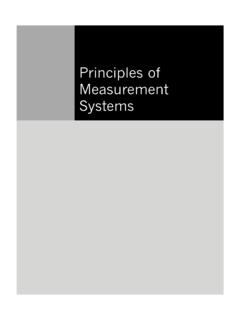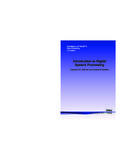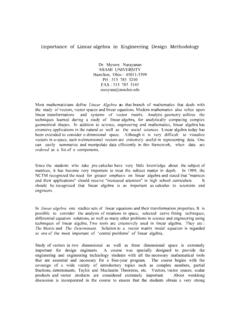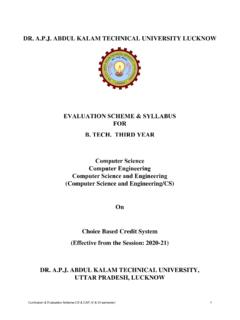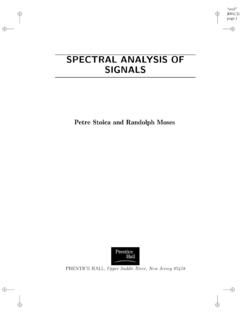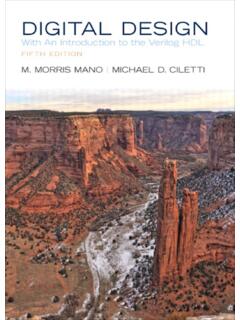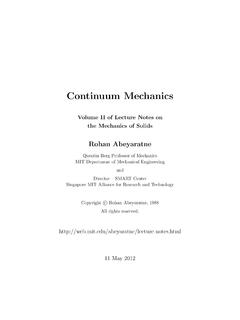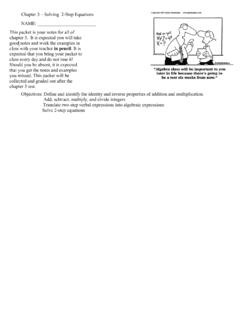Transcription of Modern Control Engineering
1 Modern Control EngineeringFifth EditionKatsuhiko OgataPrentice HallBoston Columbus Indianapolis New York San Francisco Upper Saddle RiverAmsterdam Cape Town Dubai London Madrid Milan Munich Paris Montreal TorontoDelhi Mexico City Sao Paulo Sydney Hong Kong Seoul Singapore Taipei Tokyo VP/Editorial Director, Engineering /Computer Science: Marcia J. HortonAssistant/Supervisor: Dolores MarsSenior Editor: Andrew GilfillanAssociate Editor: Alice DworkinEditorial Assistant: William OpaluchDirector of Marketing: Margaret WaplesSenior Marketing Manager: Tim Galligan Marketing Assistant: Mack PattersonSenior Managing Editor: Scott DisannoArt Editor: Greg Dulles Senior Operations Supervisor: Alan FischerOperations Specialist: Lisa McDowellArt Director: Kenny BeckCover Designer: Carole AnsonMedia Editor: Daniel SandinCredits and acknowledgments borrowed from other sources and reproduced, with permission, in thistextbook appear on appropriate page within is a registered trademark of The Mathworks, Inc.
2 , 3 Apple Hill Drive, Natick MA 2010, 2002, 1997, 1990, 1970 Pearson Education, Inc., publishing as prentice hall , One LakeStreet, Upper Saddle River, New Jersey 07458. All rights reserved. Manufactured in the United States ofAmerica. This publication is protected by Copyright, and permission should be obtained from the publisherprior to any prohibited reproduction, storage in a retrieval system, or transmission in any form or by anymeans, electronic, mechanical, photocopying, recording, or likewise. To obtain permission(s) to use materialfrom this work, please submit a written request to Pearson Education, Inc., Permissions Department, OneLake Street, Upper Saddle River, New Jersey of the designations by manufacturers and seller to distinguish their products are claimed astrademarks. Where those designations appear in this book, and the publisher was aware of a trademarkclaim, the designations have been printed in initial caps or all of Congress Cataloging-in-Publication Data on File10 9 8 7 6 5 4 3 2 1 ISBN 10: 0-13-615673-8 ISBN 13.
3 978-0-13-615673-4 CiiiContentsPrefaceixChapter 1 Introduction to Control Systems11 1 Introduction11 2 Examples of Control Systems41 3 Closed-Loop Control Versus Open-Loop Control71 4 Design and Compensation of Control Systems91 5 Outline of the Book10 Chapter 2 Mathematical Modeling of Control Systems 132 1 Introduction132 2 Transfer Function and Impulse-Response Function152 3 Automatic Control Systems172 4 Modeling in State Space292 5 State-Space Representation of Scalar Differential Equation Systems352 6 Transformation of Mathematical Models with MATLAB392 7 Linearization of Nonlinear Mathematical Models43 Example Problems and Solutions46 Problems60 Chapter 3 Mathematical Modeling of Mechanical Systems and Electrical Systems633 1 Introduction633 2 Mathematical Modeling of Mechanical Systems633 3 Mathematical Modeling of Electrical Systems72 Example Problems and Solutions86 Problems97 Chapter 4 Mathematical Modeling of Fluid Systems and Thermal Systems1004 1 Introduction1004 2 Liquid-Level Systems1014 3 Pneumatic Systems1064 4 Hydraulic Systems1234 5 Thermal Systems136 Example Problems and Solutions140 Problems152 Chapter 5 Transient and Steady-State Response Analyses1595 1 Introduction1595 2 First-Order Systems1615 3 Second-Order Systems1645 4 Higher-Order Systems1795 5 Transient-Response Analysis with MATLAB1835 6 Routh s Stability Criterion2125 7 Effects of Integral and Derivative Control Actions on System Performance2185 8 Steady-State Errors in Unity-Feedback Control Systems225 Example Problems and Solutions231 Problems263ivContentsChapter 6 Control Systems Analysis and Design by the Root-Locus Method2696 1 Introduction2696 2 Root-Locus Plots2706 3 Plotting Root Loci with MATLAB2906 4 Root-Locus Plots of Positive Feedback Systems3036 5 Root-Locus Approach to Control -Systems Design3086 6 Lead Compensation3116 7 Lag Compensation3216 8 Lag Lead Compensation3306 9 Parallel Compensation342 Example
4 Problems and Solutions347 Problems394 Chapter 7 Control Systems Analysis and Design by the Frequency-Response Method3987 1 Introduction3987 2 Bode Diagrams4037 3 Polar Plots4277 4 Log-Magnitude-versus-Phase Plots4437 5 Nyquist Stability Criterion4457 6 Stability Analysis4547 7 Relative Stability Analysis4627 8 Closed-Loop Frequency Response of Unity-Feedback Systems4777 9 Experimental Determination of Transfer Functions4867 10 Control Systems Design by Frequency-Response Approach4917 11 Lead Compensation4937 12 Lag Compensation5027 13 Lag Lead Compensation511 Example Problems and Solutions521 Problems561 Chapter 8 PID Controllers and Modified PID Controllers5678 1 Introduction5678 2 Ziegler Nichols Rules for Tuning PID Controllers568 Contentsv8 3 Design of PID Controllers with Frequency-Response Approach5778 4 Design of PID Controllers with Computational Optimization Approach5838 5 Modifications of PID Control Schemes5908 6 Two-Degrees-of-Freedom Control5928 7 Zero-Placement Approach to Improve Response Characteristics595 Example Problems and Solutions614 Problems641 Chapter 9 Control Systems Analysis in State Space6489 1 Introduction6489 2 State-Space Representations of Transfer-Function Systems6499 3 Transformation of System Models with MATLAB6569 4 Solving the Time-Invariant State Equation6609 5 Some Useful Results in Vector-Matrix Analysis6689 6 Controllability6759 7 Observability682 Example Problems and Solutions688 Problems720 Chapter 10 Control Systems Design in State Space72210 1 Introduction72210 2 Pole Placement72310 3 Solving Pole-Placement Problems with MATLAB73510 4 Design of Servo Systems73910 5 State Observers75110 6 Design of Regulator Systems with Observers77810 7 Design of Control Systems with Observers78610 8 Quadratic Optimal Regulator Systems79310 9 Robust Control Systems806 Example Problems and Solutions817 Problems855viContentsAppendix A Laplace Transform
5 Tables859 Appendix B Partial-Fraction Expansion867 Appendix C Vector-Matrix Algebra874 References882 Index886 ContentsviiThis page intentionally left blankPixPrefaceThis book introduces important concepts in the analysis and design of Control will find it to be a clear and understandable textbook for Control system coursesat colleges and universities. It is written for senior electrical, mechanical, aerospace, orchemical Engineering students. The reader is expected to have fulfilled the followingprerequisites: introductory courses on differential equations, Laplace transforms, vector-matrix analysis, circuit analysis, mechanics, and introductory main revisions made in this edition are as follows: The use of MATLAB for obtaining responses of Control systems to various inputshas been increased. The usefulness of the computational optimization approach with MATLAB has beendemonstrated. New example problems have been added throughout the book. Materials in the previous edition that are of secondary importance have been deletedin order to provide space for more important subjects.
6 Signal flow graphs weredropped from the book. A chapter on Laplace transform was deleted. Instead,Laplace transform tables, and partial-fraction expansion with MATLAB are pre-sented in Appendix A and Appendix B, respectively. A short summary of vector-matrix analysis is presented in Appendix C; this will helpthe reader to find the inverses of n x n matrices that may be involved in the analy-sis and design of Control edition of Modern Control Engineeringis organized into ten chapters. The outline ofthis book is as follows: Chapter 1 presents an introduction to Control systems. Chapter 2deals with mathematical modeling of Control systems. A linearization technique for non-linear mathematical models is presented in this chapter. Chapter 3 derives mathematicalmodels of mechanical systems and electrical systems. Chapter 4 discusses mathematicalmodeling of fluid systems (such as liquid-level systems, pneumatic systems, and hydraulicsystems) and thermal 5 treats transient response and steady-state analyses of Control is used extensively for obtaining transient response curves.
7 Routh s stabilitycriterion is presented for stability analysis of Control systems. Hurwitz stability criterionis also 6 discusses the root-locus analysis and design of Control systems, includingpositive feedback systems and conditionally stable systems Plotting root loci with MAT-LAB is discussed in detail. Design of lead, lag, and lag-lead compensators with the root-locus method is 7 treats the frequency-response analysis and design of Control systems. TheNyquist stability criterion is presented in an easily understandable manner. The Bode di-agram approach to the design of lead, lag, and lag-lead compensators is 8 deals with basic and modified PID controllers. Computational approachesfor obtaining optimal parameter values for PID controllers are discussed in detail, par-ticularly with respect to satisfying requirements for step-response 9 treats basic analyses of Control systems in state space. Concepts of con-trollability and observability are discussed in 10 deals with Control systems design in state space.
8 The discussions includepole placement, state observers, and quadratic optimal Control . An introductory dis-cussion of robust Control systems is presented at the end of Chapter book has been arranged toward facilitating the student s gradual understanding of Control theory. Highly mathematical arguments are carefully avoided in the presen-tation of the materials. Statement proofs are provided whenever they contribute to theunderstanding of the subject matter effort has been made to provide example problems at strategic points so thatthe reader will have a clear understanding of the subject matter discussed. In addition,a number of solved problems (A-problems) are provided at the end of each chapter,except Chapter 1. The reader is encouraged to study all such solved problems carefully;this will allow the reader to obtain a deeper understanding of the topics discussed. Inaddition, many problems (without solutions) are provided at the end of each chapter,except Chapter 1.
9 The unsolved problems (B-problems) may be used as homework orquiz this book is used as a text for a semester course (with 56 or so lecture hours), a goodportion of the material may be covered by skipping certain subjects. Because of theabundance of example problems and solved problems (A-problems) that might answermany possible questions that the reader might have, this book can also serve as a self-study book for practicing engineers who wish to study basic Control would like to thank the following reviewers for this edition of the book: Mark Camp-bell, Cornell University; Henry Sodano, Arizona State University; and Atul G. Kelkar,Iowa State University. Finally, I wish to offer my deep appreciation to Ms. Alice Dworkin,Associate Editor, Mr. Scott Disanno, Senior Managing Editor, and all the people in-volved in this publishing project, for the speedy yet superb production of this OgataxPreface1 Introduction to Control Systems1 1 INTRODUCTIONC ontrol theories commonly used today are classical Control theory (also called con-ventional Control theory), Modern Control theory, and robust Control theory.
10 This bookpresents comprehensive treatments of the analysis and design of Control systems basedon the classical Control theory and Modern Control theory. A brief introduction of robustcontrol theory is included in Chapter Control is essential in any field of Engineering and science. Automaticcontrol is an important and integral part of space-vehicle systems, robotic systems, mod-ern manufacturing systems, and any industrial operations involving Control of temper-ature, pressure, humidity, flow, etc. It is desirable that most engineers and scientists arefamiliar with theory and practice of automatic book is intended to be a text book on Control systems at the senior level at a col-lege or university. All necessary background materials are included in the book. Math-ematical background materials related to Laplace transforms and vector-matrix analysisare presented separately in Review of Historical Developments of Control Theories and first significant work in automatic Control was James Watt s centrifugal gover-nor for the speed Control of a steam engine in the eighteenth century.

